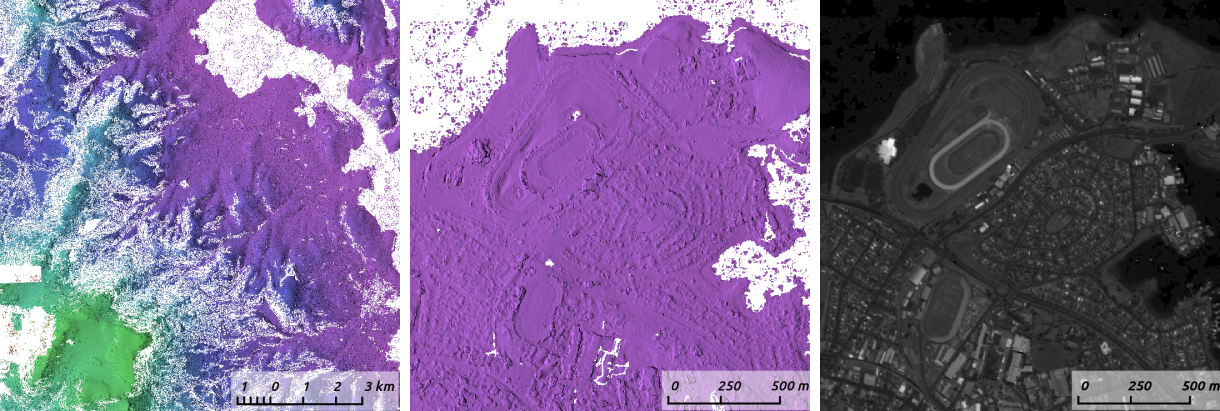8.19. RPC camera models¶
Some vendors, such as GeoEye with its Ikonos and two GeoEye satellites, Airbus, with its SPOT and Pleiades satellites, the Indian Cartosat-1 satellite, PeruSat-1, the Spanish Deimos 1 and 2, etc., provide Rational Polynomial Coefficient (RPC) camera models.
(Certain providers also offer exact linescan models. ASP supports the ones from DigitalGlobe/Maxar (Section 5), PeruSat-1 (Section 8.20), Pleiades 1A/1B (Section 8.21), and SPOT 5 (Section 8.22).)
RPC represents four 20-element polynomials that map geodetic coordinates (longitude-latitude-height above datum) to image pixels. Since they are easy to implement and fast to evaluate, RPC represents a universal camera model providing a simple approximation to complex exact camera models that are unique to each vendor. The only downside is that it has less precision in our opinion compared to the exact camera models.
In addition to supporting the provided RPC models, ASP provides a
tool named cam2rpc (Section 16.7), that can be
used to create RPC camera models from ISIS and all other cameras that
ASP understands, including for non-Earth planets (currently only the
Earth, Moon and Mars are supported). In such situations, the planet
datum must be passed to the tools reading the RPC models, as shown
below.
Our RPC read driver is GDAL. If the command gdalinfo
(Section 16.24) can identify the RPC information inside the
headers of your image files (whether that information is actually
embedded in the images, or stored separately in some auxiliary files
with a convention GDAL understands), ASP will likely be able to see it
as well. This means that sometimes we can get away with only providing
a left and right image, with no extra files containing camera
information. This is specifically the case for GeoEye, and
Cartosat-1. Otherwise, the camera files must be specified separately
in XML files, as done for DigitalGlobe/Maxar images (Section 5.2)
and PeruSat-1.
See Section 8.21.4 if the input Pleiades images arrive in multiple tiles.
For a first test, you can download an example stereo pair from GeoEye’s website at [Geo]. When we accessed the site, we downloaded a GeoEye-1 image of Hobart, Australia. As previously stated in Section 5, these types of images are not ideal for ASP. This is both a forest and a urban area which makes correlation difficult. ASP was designed more for modeling bare rock and ice. Any results we produce in other environments is a bonus but is not our objective.

Fig. 8.20 Example colorized height map and ortho image output.¶
8.19.1. Commands¶
GoeEye’s datasets have the RPC coefficients stored as part of the images. The stereo command is then:
parallel_stereo -t rpc \
--stereo-algorithm asp_mgm \
--subpixel-mode 9 \
left.tif right.tif \
results/run
For some cameras the RPC coefficients are stored in separate files ending in .RPB or _RPC.TXT (or in lower-case). These will be loaded automatically and should not be specified in the stereo command.
For Cartosat data sometimes one should overwrite the _RPC.TXT files that are present with the ones that end in RPC_ORG.TXT in order for stereo to work.
If the RPC cameras are stored separately in XML files, the stereo command is:
parallel_stereo -t rpc \
--stereo-algorithm asp_mgm \
--subpixel-mode 9 \
left.tif right.tif left.xml right.xml \
results/run
See Section 6 for a discussion about various speed-vs-quality choices.
For terrains having steep slopes, we recommend that images be mapprojected onto an existing DEM before running stereo. This is described in Section 6.1.7.
If the RPC coefficients are stored in the input images, mapproject
copies them to the output mapprojected images. If these coefficients
are in the associated .RPB or _RPC.TXT files, mapproject creates
such files for each mapprojected image.
See Section 6.1.7.8 for how parallel_stereo is invoked
with mapprojected images when the cameras are stored either separately
or part of the images.